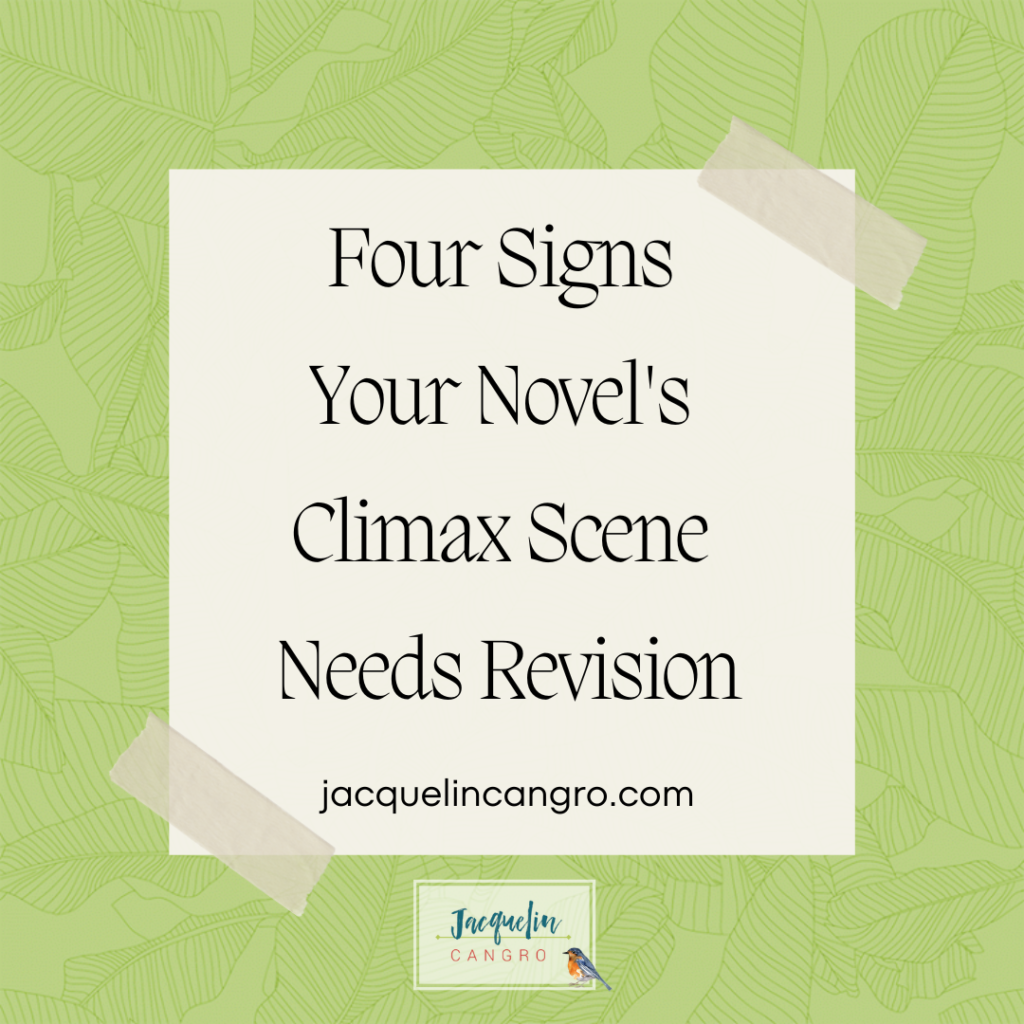Your novel’s climax scene is the BIG moment, the payoff of all that came before it. Let’s give the reader what they’ve been waiting for. How do you know if your story’s climax scene is spot on or if it needs a closer look? First, let’s review the purpose of your novel’s climax scene.
What is your novel’s climax scene?
The climactic moment in a novel or memoir is the pivotal scene that leads to the protagonist reaching (or failing to reach) the goal they set out to achieve. It’s Harry Potter vanquishing Voldemort. It’s Frodo destroying the ring in the fires of Mordor. It’s Scrooge facing the possibility of Christmas Yet to Come.
Whether you have a quiet, character-driven story or an epic fantasy, your story’s climax is the scene when the events of the story culminate in the protagonist facing their biggest obstacle. Yet I edit many novels in which the climactic moments have the potential to leave the reader unsatisfied. Here are four signs that the climax scene needs revision.

1. The protagonist is not facing their most difficult obstacle
In the Western tradition of storytelling, most stories are structured on rising action. The protagonist faces more difficult and more complex hurdles throughout the story until it all culminates in this one final battle. For the fantasy or science fiction genres, this scene is usually exactly that — a battle between the hero and villain, between good and evil. But in a character-driven story, a “battle” can mean the protagonist facing their biggest fear or challenge.
Is your protagonist is being tested like they’ve never been tested before? Have they reached the point with the ultimate stakes or consequences? This doesn’t have to be literal life or death, but it should feel like life or death to your protagonist.
2. The major conflict is not resolved in the climax
The point of the climactic moment is to bring the story’s most important conflict to an end. This is the scene where we find out if the protagonist reaches their goal or not, and it answers the overarching story question. This doesn’t mean that your story needs to have a tidy ending, only that the reader should know what happens with the conflict that has been propelling the characters.
There is an exception to resolving the major conflict in the climax if you’re writing a series. In that case, the major conflict is likely not resolved until the final book, though each book should have its own conflict that is wrapped up in the climax of that book.
3. The major conflict is resolved too early
As an editor, I’ve reviewed manuscripts in which the protagonist confronts their biggest obstacle around the middle of the story, which causes the second half of the book to drag on. One way to ensure this doesn’t happen in your story is to consider what the climactic moment will be for your characters. What are they galloping toward? Where are all of their decisions leading them? What could be the biggest obstacle that they would have to overcome before achieving their goal? Then make sure this doesn’t happen until the middle of the third act.
4. The climax feels out of place
Sometimes, in trying to create the biggest, most challenging moment of the story, a writer will develop a scene that isn’t in synch with the characters, the tone or the plot. If your characters are in a situation that doesn’t make sense or if they’re making random decisions just to set up this over the top climax, it will feel forced.
The plot points leading to the climax should be building to this inevitable showdown, one that will challenge your protagonist to make a decision that helps them reach their goal, not one that is dramatic for the sake of being dramatic.
Pair this post with my previous post about Seven Essential Elements of a Scene for a solid overview of how to craft a compelling climax scene.
_______________________
NEW ONLINE CLASS ALERT! If you want to learn more about writing a compelling, memorable climax, I’ll be teaching a three-hour seminar at GrubStreet on February 4 called Unlock Your Story’s Climax where we’ll cover:
- The techniques for creating a dynamic climax that will stay with the reader
- How to ensure the payoff matches the build-up
- How to structure this scene no matter what genre you’re writing


